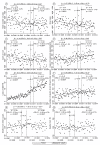Evaluation of the impact that the changes in tuberculosis treatment implemented in Brazil in 2009 have had on disease control in the country
- PMID: 29340492
- PMCID: PMC5792043
- DOI: 10.1590/S1806-37562017000000004
Evaluation of the impact that the changes in tuberculosis treatment implemented in Brazil in 2009 have had on disease control in the country
Abstract
Objective: To analyze the impact that the 2009 changes in tuberculosis treatment in Brazil had on the rates of cure, tuberculosis recurrence, mortality, treatment abandonment, and multidrug-resistant tuberculosis (MDR-TB).
Methods: An ordinary least squares regression model was used in order to perform an interrupted time series analysis of secondary data collected from the Brazilian Tuberculosis Case Registry Database for the period between January of 2003 and December of 2014.
Results: The 2009 changes in tuberculosis treatment in Brazil were found to have no association with reductions in the total number of cases (β = 2.17; 95% CI: -3.80 to 8.14; p = 0.47) and in the number of new cases (β = -0.97; 95% CI: -5.89 to 3.94; p = 0.70), as well as having no association with treatment abandonment rates (β = 0.40; 95% CI: -1.12 to 1.93; p = 0.60). The changes in tuberculosis treatment also showed a trend toward an association with decreased cure rates (β = -4.14; 95% CI: -8.63 to 0.34; p = 0.07), as well as an association with increased mortality from pulmonary tuberculosis (β = 0.77; 95% CI: 0.16 to 1.38; p = 0.01). Although there was a significant increase in MDR-TB before and after the changes (p < 0.0001), there was no association between the intervention (i.e., the changes in tuberculosis treatment) and the increase in MDR-TB cases.
Conclusions: The changes in tuberculosis treatment were unable to contain the decrease in cure rates, the increase in treatment abandonment rates, and the increase in MDR-TB rates, being associated with increased mortality from pulmonary tuberculosis during the study period.Keywords: Tuberculosis, pulmonary/epidemiology; Tuberculosis, pulmonary/drug therapy; Tuberculosis, pulmonary/mortality; Interrupted time series analysis; Drug resistance, multiple; Drug compounding.
Objetivo:: Analisar o impacto das mudanças do tratamento da tuberculose implantadas no Brasil em 2009 no número de casos de cura, de recidiva, de óbitos, de abandono e de tuberculose multirresistente (TBMR).
Métodos:: Foi realizada uma análise de séries temporais interrompida utilizando o modelo de regressão pelo método dos mínimos quadrados ordinários a partir de dados secundários coletados do Sistema de Informação de Agravos de Notificação da Tuberculose entre janeiro de 2003 e dezembro de 2014.
Resultados:: A análise mostrou independência entre as mudanças do tratamento e a redução do número total de casos (β = 2,17; IC95%: −3,80 a 8,14; 189 p = 0,47), a redução do número de novos casos (β = −0,97; IC95%: −5,89 a 3,94; p =190 0,70) e do abandono do tratamento (β = 0,40; IC95%: 199 −1,12 a 1,93; p = 0,60). Demonstrou ainda tendência à associação com a diminuição da cura (β = −4,14; IC95%: −8,63 a 0,34; p = 0,07) e associação com aumento da mortalidade por tuberculose pulmonar (β = 0,77; IC95%: 0,16 a 1,38; p = 0,01). A TBMR aumentou significativamente tanto no período anterior quanto no período posterior às mudanças do tratamento (p < 0,0001), embora de forma independente da intervenção (β = 0,13; IC95%: −0,03 a 0,29; p = 0,12).
Conclusões:: As mudanças no tratamento não impediram nem a diminuição na taxa de cura e nem o aumento do abandono e da TBMR; por outro lado, se associaram ao aumento de óbitos por tuberculose pulmonar durante o período do estudo.
Figures


Comment in
-
Reflections upon the article "Evaluation of the impact that the changes in tuberculosis treatment implemented in Brazil in 2009 have had on disease control in the country"Authors' replyEvaluation of the impact that the changes in tuberculosis treatment implemented in Brazil in 2009 have had on disease control in the countryHow Do You Know Which Health Care Effectiveness Research You Can Trust A Guide to Study Design for the PerplexedSegmented regression analysis of interrupted time series studies in medication use researchConducting interrupted time series analysis for single-and multiple-group comparisonsInterrupted time series regression for the evaluation of public health interventions a tutorialHow to obtain the confidence interval from a P value.J Bras Pneumol. 2018 May-Jun;44(3):249-252. doi: 10.1590/S1806-37562018000000096. J Bras Pneumol. 2018. PMID: 30043894 Free PMC article. No abstract available.
References
-
- World Health Organization . Global Tuberculosis Report. Geneva: WHO; 2016. http://www.who.int/tb/publications/global_report/en
-
- Conde MB, Melo FA, Marques AM, Cardoso NC, Pinheiro VG, Dalcin Pde T. III Brazilian Thoracic Association Guidelines on tuberculosis. J Bras Pneumol. 2009;35(10):1018–1048. https://doi.org/10.1590/S1806-37132009001000011 - DOI - PubMed
-
- Brasil. Ministério da Saúde. Secretaria de Vigilância em Saúde. Departamento de Vigilância Epidemiológica. Programa Nacional de Controle da Tuberculose . Nota técnica sobre as mudanças no tratamento da tuberculose no Brasil para adultos e adolescentes - Versão 2. Brasília: Ministério da Saúde; http://www1.saude.rs.gov.br/dados/1293729099101Nota%20T%E9cnica%20-%202%...
-
- Brasil. Ministério da Saúde. Secretaria de Vigilância em Saúde. Departamento de Vigilância Epidemiológica . Manual de recomendações para o controle da tuberculose no Brasil. Brasília: Ministério da Saúde; 2011.
-
- Santos LA, Galesi VM. Mudança no esquema de tratamento da tuberculose. Bepa. 2010;7(73):28–32.
MeSH terms
Substances
LinkOut - more resources
Full Text Sources
Other Literature Sources

